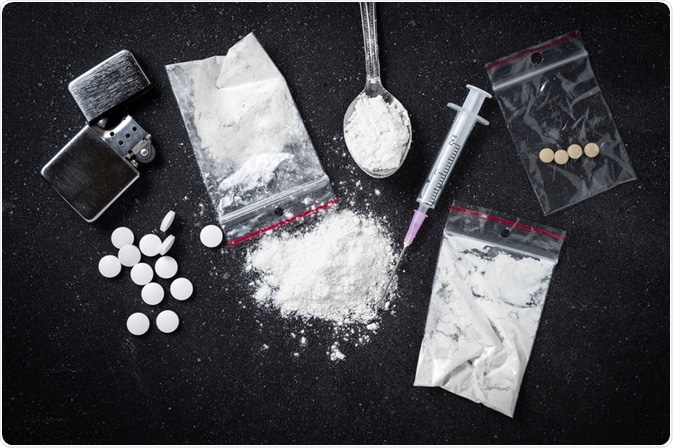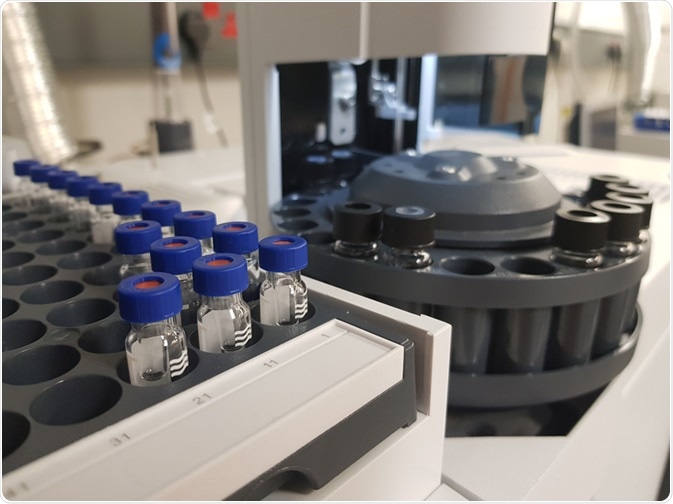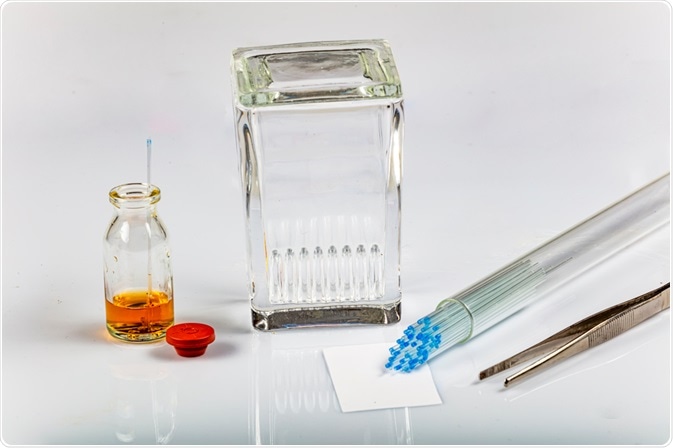In addition to routine drug tests that are required by employers, drug detection methods are also widely used within the field of forensic toxicology and for border security purposes. There is a wide range of analytical techniques that are capable of identifying and measuring drug concentrations within different sample types.

Image Credit: Leszek Czerwonka/Shutterstock.com
The importance of drug detection
One of the main causes of high criminal activities is drug addiction and abuse, both of which are significant problems that affect populations around the world.
In addition to the excessive use of psychotropic substances, hallucinogens, and natural drugs, a new collection of psychoactive substances that have been designed from the skeletons of natural drugs are causing new analytical methodologies to be needed now more than ever.
These types of analyses are not only critical during criminal investigations but are also required during the investigation of unexpected deaths to determine whether the death was due to a drug overdose, poisoning, or environmental exposure.
Mass spectrometry techniques
Within the field of forensic toxicology, mass spectrometry (MS) methods are considered to be the gold standard in the identification and quantification of drugs. Typically, MS methods are coupled with different chromatography techniques to identify and quantify metabolites from unknown drugs during the toxicological analysis.
Some of the most commonly used techniques that couple chromatography with MS include gas chromatography-MS (GC-MS), liquid chromatography-MS (LC-MS), LC-MS in tandem (LC-MS/MS), and two-dimensional GC-MS (GC x GC-MS).
GC-MS
It is generally a requirement that samples that are analyzed by GC-MS must be of low molecular weight and volatile. When incorporated into the toxicological analysis of drugs, GC-MS offers high selectivity, detectability, and robustness in the characterization of drugs present in blood, urine, saliva, and hair samples.
To improve the detection and identification of specific drugs using GC-MS, various negative and positive modes of MS analysis have been integrated into this combined technique.
For the analysis of opiates, amphetamines, and ketamines in human hair, for example, some studies have found that combining GC-MS with electron ionization MS (GC-EI-MS). In this work, drug concentrations as low as several pictograms (pg) could be identified from only 25 milligrams (mg) of the sample.
In addition to offering enhanced sensitivity capabilities, this mode of GC-MS can also avoid misinterpretations of data and eliminate any inaccurate results through lower limits of detection. Another methodology involving GC-MS and EI has been used to identify and quantify heroin and cocaine levels in samples.
In this latter method, a supersonic molecular beam (SMB) acts as the interface of the GC to provide mass spectra with enhanced molecular ions that can be used to correlate data with reference libraries.

Image Credit: a_viewfinder/Shutterstock.com
Read more about how GC-MS works here!
LC-MS
LC is a highly versatile chromatography technique that can separate both volatile and nonvolatile analytes. As a result, amphetamines, benzodiazepines, hallucinogens, cannabinoids, opiates, cocaine, designer drugs, pharmaceutical products, and a wide range of illicit drugs present in different matrices have been detected and analyzed by this method.
The method of ionization plays a crucial factor in determining the accuracy and sensitivity of identifying compounds by LC-MS. One recent study found that three different types of ionization, of which include electrospray ionization (ESI), atmospheric-pressure chemical ionization (APCI), and atmospheric-pressure photoionization (APPI) were ideal for evaluating chemical suppression during the analysis of 17 different illicit drugs present in a total volume of 100 microliters (µl) of oral fluids.
Immunoassays
Aside from GC-MS and other spectrometry methods that are considered to be the most discriminatory drug testing technologies available, several lower discriminatory testing, such as immunoassays, can also be used to detect common drugs.
Whereas the costs associated with GC-MS can range from $5,000 to as much as $200,000 and require intermediate to advanced operation knowledge, immunoassays typically require an initial cost of anywhere between $5,000 to $20,000 for the equipment and recurring costs of $300 to $1,000 per month, depending upon the volume of usage.
The basic working principle of any immunoassay is dependent upon the ability of an antibody that is specific to a drug or drug group of interest to bind to an antigen in the sample. This binding will result in the antibody-antigen complex that will then be labeled to allow for its detection, which can be achieved by fluorescence, colorimetric or other types of quantification strategies.
Typically, an immunoassay is used as the initial qualitative test to determine whether a certain drug or drug class is present within a sample, which is typically urine. Some of the different types of drugs that can be rapidly detected by immunoassays include marijuana, cocaine, opiates, amphetamines, phencyclidine (PCP), and fentanyl.
Thin-layer chromatography
Another common technique that is lower discriminatory than GC-MS but still widely used is thin-layer chromatography (TLC). The TLC technique begins with the placement of the sample of interest onto a stationary phase.
The stationary phase is then placed in a liquid mobile phase which promotes the movement of the sample by capillary action. To this end, the absorption of the analyte by either the stationary phase or the mobile phase is determined by the size and affinity of the components within the sample for either the mobile or stationary phase.
Within forensic toxicology, TLC can be used for the detection of a wide range of drugs including barbiturates, benzodiazepines, heroin, morphine, opium, oxycodone, amphetamines, cocaine, ketamine, and several others.
TLC is a low-cost, sensitive, and rapid technique that can be used as a presumptive test; however, it is insufficient in its ability to quantify the amount of drug is present within a sample. Therefore, TLC is best used when combined with higher discriminatory techniques like GC-MS or Raman spectroscopy.

Image Credit: Mehmet Cetin/Shutterstock.com
References and Further Reading
- Mogollon, N. G. S., Quiroz-Moreno, C. D., Prata, P. S., et al. (2018). New Advances in Toxicological Forensic Analysis Using Mass Spectrometry Techniques. Journal of Analytical Methods in Chemistry. doi:10.1155/2018/4142527.
- Van Hese, L., Vaysse, P., Siegel, T. P., et al. (2020). Real-time drug detection using diathermic knife combined to Rapid Evaporative Ionisation Mass Spectrometry. Talanta. doi:10.1016/j.talanta.2020.121391.
- Raouf, M., Bettinger, J. J., & Fudin, J. (2018). A Practical Guide to Urine Drug Monitoring. Federal Practitioner 35(4); 38-44. PMID: 30766353.
- Harper, L., Powell, J., & Pijl, E. M. (2017). An overview of forensic drug testing methods and their suitability for harm reduction point-of-care services. Harm Reduction Journal 14(52). doi:10.1186/s12954-017-0179-5.
Further Reading
Last Updated: Sep 13, 2022